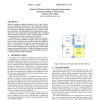Free Online Productivity Tools
i2Speak
i2Symbol
i2OCR
iTex2Img
iWeb2Print
iWeb2Shot
i2Type
iPdf2Split
iPdf2Merge
i2Bopomofo
i2Arabic
i2Style
i2Image
i2PDF
iLatex2Rtf
Sci2ools
3DIC
2009
IEEE
2009
IEEE
Architectural evaluation of 3D stacked RRAM caches
The first memristor, originally theorized by Dr. Leon Chua in 1971, was identified by a team at HP Labs in 2008. This new fundamental circuit element is unique in that its resistance changes as current passes through it, giving the device a memory of the past system state. The immediately obvious application of such a device is in a non-volatile memory, wherein high- and low-resistance states are used to store binary values. A memory array of memristors forms what is called a resistive RAM or RRAM. In this paper, we survey the memristors that have been produced by a number of different research teams and present a point-by-point comparison between DRAM and this new RRAM, based on both existent and expected near-term memristor devices. In particular, we consider the case of a die-stacked 3D memory that is integrated onto a logic die and evaluate which memory is best suited for the job. While still suffering a few shortcomings, RRAM proves itself a very interesting design alternative ...
| Added | 18 May 2010 |
| Updated | 18 May 2010 |
| Type | Conference |
| Year | 2009 |
| Where | 3DIC |
| Authors | Dean L. Lewis, HsienHsin S. Lee |
Comments (0)

